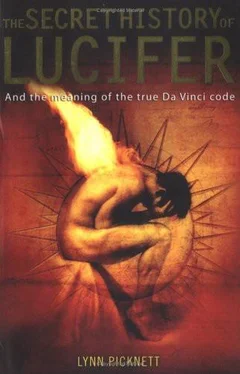But does spending the night unclad with a religious teacher automatically imply that some kind of homosexual activity took place? Of course not, but Professor Smith himself had no doubts about Jesus' `libertine circle', and the possibility that his followers were admitted, `singly and by night, to the mystery of the kingdom, by certain ceremonies derived from ancient erotic magic' 25 Based on his knowledge of this tradition, Smith conjectures that the young man's thin linen garment was removed and his naked body immersed in a baptismal pool or bath to a background of prayers `and some kind of rite of manipulation' - presumably masturbation, possibly prior to other sexual rituals - accompanied by a breath control technique that induced ecstasy, and possibly a hallucination of heavenly bliss. `The disciple was possessed by the spirit of Jesus and so united with him.'26 Professor Smith surmised that `Freedom from the [Jewish] law may have resulted in completion of the spiritual union by physical union.'27
Perhaps it is significant that, as Marilyn Yalom points out in her A History of the Wife (2001): `As for Christianity, Jesus said nothing on the subject of homosexuality - and this in contrast to numerous condemnations of adultery.'28 (While discussing the pressure on Sr Buttiglione to stand down from the European Commission in November 2004 because of his traditionalist values, Daily Mail columnist Andrew Alexander also noted: `For myself, I would delight in debating with our Italian friend why homosexuality is not singled out for condemnation in the gospels. Was it due to the gospels' authors failing to take proper notes, or divine incompetence or what?')29 Yalom points out that the criticism of same-gender sexuality originated in the Christian movement with Saint Paul, who `explicitly condemned both male and female homosexuality (Romans 1:26-27, I Corinthians 6:9, and 1 Timothy 1:10Y.11
Of course a zealous Christian will simply deny the authenticity of this secret gospel and carry on believing as if it had never been drawn to his or her attention. After all, there is a distinct architecture to the faith: significant constructs are made that surround the character and the traditions of Christ; dogma that then becomes immovable, and the whole carapace hardens with time and belief. But what if the implications of the secret gospel are sound? What if Jesus' movement was really based on initiation and mysteries - including rites of a strongly erotic or even homosexual nature? Suddenly what was considered demonic, devilish, satanic, would be inexorably linked with Jesus Christ, hitherto the very epitome and literal embodiment of noble chastity. It is surely unthinkable.
In fact, there is considerably more evidence, albeit for obvious reasons circumstantial after all this time, that Jesus and his initiates were involved in the sort of cult behaviour that modern Christians would not only condemn as filthy and immoral, but actively seek to have banned from their community. This is where polarized notions of good and evil, the godly and the Luciferan, or outright Satanic, become merely the stuff of bias and therefore fair game for debate.
Lazarus, the youth involved in some kind of ritual rebirth or sexual initiation into the mysteries of the Kingdom, had two sisters - the house-proud Martha and the mysterious Mary, also known as the Magdalene, whose character and role have been discussed in detail in my previous book, Mary Magdalene: Christianity's Hidden Goddess (2003) 31 She is `mysterious' because she appears only rarely by name in the New Testament, her identity also being obscured as `Mary of Bethany', `a certain woman' or `a sinner of the town'.
Although any church goer will be quick to describe her as the reformed prostitute who foreswore her wicked ways to follow Jesus, in fact her alleged career as a street-walker was an invention of Pope Gregory I in 691 CE, based on the biblical description of her as `a sinner'. He simply put two and two together and made five: the original Greek word was harmartolos, a term taken from archery meaning `one who falls short of the mark' and was applied to those who, for whatever reason, failed to keep the Jewish Law. One major reason for not doing so, of course, was not being Jewish - a foreigner - or perhaps a follower of another type of Judaism. As discussed in my previous book, there is evidence to link Mary Magdalene primarily with Egypt, and possibly with the ancient goddess cults of Ethiopia.
Not only did the Church vilify her as a whore, but the writers of the canonical gospels clearly set out to marginalize her. In the canonical gospels she only really comes into her own at the crucifixion, when she heads a team of Jesus' female disciples who come to show their solidarity with and love for their stricken leader, when the famous men - apart from the young Saint John - have fled. She, too, takes a major role in the story of the resurrection, where she meets the risen Jesus in an almost exact re-enactment of the Egyptian mystery plays of Isis and Osiris. Yet her abrupt appearance as a significant player in the great drama seems odd until it is realized that she had been deliberately edited out of the story until it reached the point where she had to take centrestage, perhaps simply because her part in the story was too well known to leave out. But why was her role demoted and degraded in this way? What did the writers of the gospels of Saints Matthew, Mark, Luke and John have against one apparently harmless and devout woman?
Many people would answer that the men of the early Church were too biased against an ex-prostitute to permit her to take the limelight, or that, being basically still patriarchal Jews, they were just too sexist. In fact, the answer is almost certainly rather different - and considerably more far-reaching. Mary Magdalene committed what to the early Christian men of Judaea must have been an act of blasphemous presumption, for anyone, let alone a woman who was probably foreign and possibly black (as noted previously,32 racism was not invented by the British Empire). She anointed Jesus. It happened in Bethany at the home of a man known to history simply as Simon the Leper - probably fictitious - as described in Mark's Gospel:
a woman came in with an alabaster jar of very expensive perfume, made of pure [spike]nard. She broke the jar and poured the perfume on his head.
Some of those present were saying indignantly to one another, `Why this waste of perfume? It could have been sold for more than a year's wages and the money given to the poor.' And they rebuked her harshly 33
In Luke's Gospel, the unnamed woman anoints his head and feet and also dries them with her hair.34 But if the men's objection was intended to provoke praise and gratitude from Jesus, it failed utterly. Instead of congratulating them on their wisdom and concern for the poor, their leader says vehemently:
Leave her alone ... Why are you bothering her? She has done a beautiful thing to me. The poor you will always have with you, and you can help them any time you want. But you will not always have me. She did what she could. She poured perfume on my body beforehand to prepare for burial ...3s
The last sentence contains a clue to the real significance of her action. It was not, as has been suggested, merely a kind of ad hoc aromatherapy, a compassionate and pleasant thing for the townswoman to do to show her devotion to Jesus. This was a ritual anointing and as such is of enormous significance: for Jesus' title of Christos/Christ means `Anointed One' - and as the only anointing mentioned in the whole of the New Testament is performed by a woman, surely it should be celebrated as a major rite of Christianity. Indeed, Jesus says forcefully, `She poured perfume on my body to prepare for my burial', but that burial, Christians believe, was unlike any other interment, for Jesus triumphed over death and the tomb to fulfil his destiny as the incarnate deity, the risen sacrificial king. In anointing him she Christened him, and marked him out for his fateful death. The true meaning of the ritual was completely lost on the other disciples, but Jesus tries hard to impress Mary Magdalene's importance on them, saying sternly: `I tell you the truth, wherever the gospel is preached throughout the world, what she has done will also be told in memory of her.'36
Читать дальше












